英国文学史十八世纪 前浪漫主义 47页PPT文档
英国浪漫主义文学.ppt.Convertor

Did He who made the Lamb make thee?
Tiger! Tiger! burning bright
In the forests of the night,
What immortal hand or eyes
Dare frame thy fearful symmetry?
照亮了心灵上空
在怎样的熔炉中炼成你的脑筋?
是怎样的铁砧?怎样的铁臂
敢于捉着这可怖的凶神?
群星投下了他们的投枪。
用它们的眼泪润湿了穹苍,
他是否微笑着欣赏他的作品?
他创造了你,也创造了羔羊?
老虎!老虎!黑夜的森林中
燃烧着的煌煌的火光,
是怎样的神手或天眼
造出了你这样的威武堂堂?
(二)前期代表:“湖畔派诗人”Lake Poets
The smiles that win, the tints that glow
But tell of days in goodness spent,
A mind at peace with all below,
A heart whose love is innocent.
I saw thee weep我见过你哭
I saw thee weep—the big bright tear
我见过你哭——晶莹的泪珠
Came o’er that eye of blue;
从蓝眼睛滑落
And then me thought it did appear
像一朵梦中出现的紫罗兰
A violet dropping dew
滴下清透的露珠
第三节
英国浪漫主义文学
《浪漫主义文学》课件

REPORT
CATALOG
DATE
ANALYSIS
SUMMAR Y
02
浪漫主义文学代表人物 及作品
英国的代表人物及作品
代表人物
拜伦、雪莱、济慈
作品
《恰尔德·哈洛尔德游记》、《西风颂》、《夜 莺颂》
特点
强调个人情感、反对压迫和束缚、追求自由和解放
法国的代表人物及作品
代表人物
雨果、乔治·桑、缪塞
作品
社会影响的比较
对社会观念的影响
浪漫主义文学推动了个性解放和情感表达, 现实主义文学则促进了社会批判和改革。
对文学发展的影响
浪漫主义文学为后来的现代主义文学打下了基础, 现实主义文学则成为现代小说的重要源头。
对其他艺术领域的影响
浪漫主义文学对音乐、绘画等艺术领域产生 了深远影响,现实主义文学则对电影、戏剧 等艺术形式产生了重要影响。
创作理念的比较
01
创作理念的起源
浪漫主义文学起源于18世纪末至19世纪初的欧洲,现实主义文学则兴
起于19世纪中后期。
02
创作理念的特点
浪漫主义文学强调个性、情感和想象力,追求理想和美好,而现实主义
文学则注重客观、真实和细节,反映社会现实问题。
03
创作目的
浪漫主义文学的目的是表达情感、追求自由和个性,现实主义文学则旨
在揭示社会现象、批判现实。
作品风格的比较
作品主题
浪漫主义文学作品主题多为自然 、情感、理想和英雄主义,现实 主义文学作品主题则关注社会问 题、人性矛盾和心理描写。
作品形式
浪漫主义文学作品形式多样,包 括诗歌、小说、戏剧等,现实主 义文学作品则更注重结构和情节 的严谨。
作品语言
英国文学史(浪漫主义时期)

英国文学史(浪漫主义时期)浪漫主义时期,其实从18世纪中叶已经开始了,罗伯特·彭斯和威廉·布莱克,开了个先河,到19世纪,华兹华斯拉开序幕,再到司各特去世,浪漫主义时代结束,其中鼎盛时期不过30多年,这一时期要讲的主要是六个诗人湖畔派诗人那三个较为消极的还有拜伦雪莱那一伙积极的,再加上浪漫主义时期的小说简·奥斯丁,还有一个司各特。
多的可能会补充。
这块先看看背景,再说一下,浪漫主义为什么会在英国兴起。
一、历史背景政治上来讲,当时英国的情况,应该是工业革命,资本主义迅速发展,成为世界工厂。
文化上面,当时法国大革命,启蒙思想已经到了高潮,人民追求自由、平等之思想已经到了极致,可是呢,法国大革命一结束,启蒙思想家所谓革命之后的理想社会,并没有出现,这个时候,整个社会,都弥漫着一股失望的情绪,对于原来古典主义所谓追求理性的观点,产生了排斥,不少作家开始,追求自我精神世界,强调自由、自然、自我,注重主观精神世界的表现。
这个时候,经过感伤主义和前浪漫主义时期的铺垫,浪漫主义时期来临,诗歌上面得到极大发展,当然流行的都是抒情诗(lyrics),最先开始就是以华兹华斯为代表的湖畔派诗人(Lake poets),这一派因为隐居于英国西北部的湖区得名,又应诗歌题材大多写田园生活,远离尘世,显得十分消极,华兹华斯和柯勒律治合编的《抒情歌谣集》(The lyrical ballads)下面先来讲一下,华兹华斯。
二、代表人物诗歌:1、挚爱自然的华兹华斯(William Wordsworth)华兹华斯出生于一个律师家庭,读书的时候,除了学习拉丁语和古典文学就是流连于山水之间,培养对自然的爱好,后来他去了剑桥大学读书,期间,研究斯宾塞,乔叟等人的文学,随后,徒步旅行到法国,被法国革命提出的“自由”、“平等”的口号所吸引,在那里住了一年多,随后“九月大屠杀”和雅各宾派的恐怖统治,大大地浇灭了他对于革命地热情,在朋友的帮助下,在湖区的乡舍中住了两年,这个时期基本热心于创作,期间还认识了柯勒律治,两个人经常相互切磋诗艺,1798年,就联手出版了《抒情歌谣集》,开一代诗风,诗集没出版的时候,华兹华斯就在致力于写作他自己的《序曲》(The Prelude ),后面就是在他离世之前,分别迁过两次,都在湖区住了七八年。
英国文学史PPT课件

Robinson Crusoe, Gulliver’s Travels
-
1
The Enlightenment Period
Historical and cultural background:
1 After the tempestuous events of the 17th century, England entered a period of comparatively peaceful development.
permanently flawed.
-
12
The Enlightenment Period
Major Writers of the period
Jonathan Swift (1667 -1745) Major works
A Tale of a Tub (1704) a religious satire, the adventures of three brothers: Peter --- Roman Catholicism, Martin --- church of England, Jack --- the Dissenters. a satire on all branches of Christianity.
society that forces Moll to repeated sins and crimes
-
8
The Enlightenment Period
Major Writers of the period
Daniel Defoe (1660 -1731) Major works
Robinson Crusoe (1791) celebrating the 18th-century Western
第五章 18世纪文学 (《外国文学史》PPT)
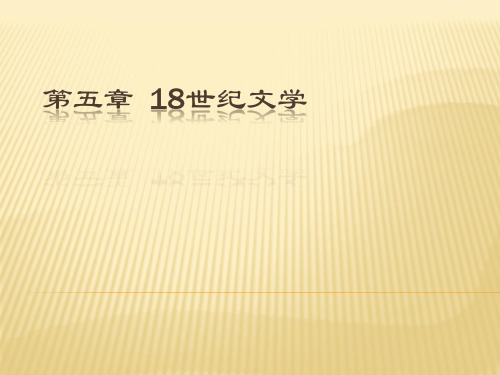
从显性层面上来说,这部小说的最大贡献 在于成功地塑造了鲁滨逊这一资产阶级上升 时期的正面典型形象。 但从象征层面来看,鲁滨逊所处的海上 “荒岛”其实是人类远古生活状态的象征。
乔纳森•斯威夫特(1667—1745)是英国启 蒙主义文学中杰出的讽刺作家,作品有小说、 诗歌、散文和书简。小说《格列佛游记》 (1726)是他讽刺文学中最为出色的作品。
高特荷德•艾弗拉姆•莱辛 (1729—1781)是德国启 蒙运动的杰出代表,也是 德国民族文学的奠基人。
莱辛著作颇丰,理论著作有《汉堡剧评》 (1767—1769)、《拉奥孔,论绘画和诗歌 的界限》(1766)等。在美学理论上,他强 调艺术必须克服脱离现实的倾向,要发挥各 种艺术形式的特性,真实而生动地反映现实。
伏尔泰(1694—1778)原名弗朗索瓦•马利 •阿鲁埃。文学创作中成就最大的就是哲理小 说,一共出版了26部之多。著名作品有《査 第格》(1748)、《老实人》(1759)、 《天真汉》(1767)等。
德尼•狄德罗(1713—1784)是法国新一代 杰出的启蒙思想家和作家。他组织和主编的 《百科全书》成为新兴资产阶级与反动势力 进行斗争的理论阵地,并以此把法国启蒙运 动推向高潮。
女皇叶卡捷琳娜二世(1762—1796)即位 之初,假意接受启蒙思想,标榜“开明君主” 制度,鼓励文学创作,出版杂志,并亲自动 笔写作,但其目的是要使文学为其统治服务。
杰尼斯•伊凡诺维奇•冯维辛(1744—1792) 是俄罗斯最早出现的具有启蒙思想的作家之 一。
亚历山大•尼古拉耶维奇•拉 吉舍夫(1749—1802)是较为 激进的俄国启蒙学者之一。他 写过哲学、政论著作和文学作 品,其中最重要的是《从彼得 堡到莫斯科旅行记》(1790)。
18世纪的欧洲出现了一次更为伟大的思想 解放运动——“启蒙运动”。 它于17世纪最早萌芽于英国与荷兰,随后 在法国、德国、俄国、意大利等国广泛传播 开来,成为思想文化的主潮。其中,法国启 蒙主义运动最具典型性。
英国文学简史-18th-century(1)PPT课件
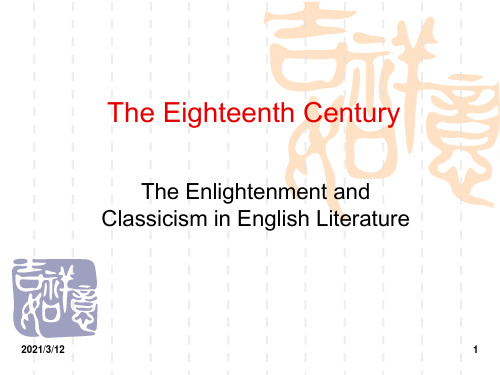
man as an imperfect being, inherently sinful, whose potential was limited.
emphasis on order and reason, on restraint, on common sense
Enlightenment Movement
The England Enlightener (P127)
2021//12
2
The 18th Century England
comparatively peaceful development
In politics
a constitutional monarchy
2021/3/12
11
Dissimilarities in Point of View
man as a being fundamentally good and possessed of an infinite potential for spiritual and intellectual growth.
2021/3/12
5
The Features of English Enlightenment
▪ (1)English enlighteners believed in the power of reason. That is why the 18th century has often been called “the age of reason” or “the kingdom of reason”.
3
《浪漫主义文学》课件

03
浪漫主义文学的影响和意 义
对世界文学的影响
推动文学创新
浪漫主义文学强调个人情感和想 象力,打破了古典主义文学的限 制,为世界文学带来了新的创作
理念和风格。
拓展文学题材
浪漫主义文学拓展了文学的题材范 围,将自然、历史、神话、民间传 说等元素融入作品,丰富了文学的 表现形式。
促进国际交流
浪漫主义文学成为各国文学交流的 重要桥梁,不同国家的浪漫主义作 家相互影响、借鉴,推动了世界文 学的发展。
《浪漫主义文学》 漫主义文学代表人物及作品 • 浪漫主义文学的影响和意义 • 浪漫主义文学在现代社会的应用
和价值 • 浪漫主义文学的未来发展与展望
01
浪漫主义文学概述
浪漫主义文学的定义
浪漫主义文学
18世纪末至19世纪初欧洲文学的一个 重要流派,强调个人情感、自然和想 象力的表达,反对严格的规则和形式 。
关注个体情感
浪漫主义文学强调个体情感和内心世界,启示我 们在现代社会中关注个体情感需求和心理健康。
追求精神价值
浪漫主义文学追求精神价值和理想信念,鼓励我 们在现代社会中坚守信仰和追求美好生活。
3
人与自然和谐共生
浪漫主义文学描绘自然之美和人与自然的和谐关 系,启示我们要尊重自然、保护环境,实现人与 自然和谐共生。
乔治·戈登·拜伦
总结词
乔治·戈登·拜伦是英国浪漫主义文学的重要代表之一,他的诗歌以反叛、孤独和自由为 主要特点。
详细描述
乔治·戈登·拜伦是19世纪初英国的一位杰出诗人,他的诗歌作品充满了反叛、孤独和自 由的元素,常常通过描绘个人与社会之间的矛盾来表达对自由和个体价值的追求。他的
代表作品有《恰尔德·哈洛尔德游记》、《唐璜》等。
《英国浪漫主义文学》课件

18世纪末至 19世纪初, 英国社会变 革剧烈,工 业革命、政 治改革等推 动了社会进 步
浪漫主义文 学反对古典 主义,强调 个性解放和 情感表达
浪漫主义文 学受到德国 古典哲学、 法国启蒙运 动等思想的 影响
浪漫主义文 学强调自然、 情感、想象 力和个性, 反对理性、 逻辑和传统
浪漫主义文 学的代表人 物有拜伦、 雪莱、济慈 等
艺术特色:浪漫主义风格, 充满激情和想象力
影响:对欧洲文学和思想 产生了深远影响
评价:被誉为英国浪漫主 义文学的代表作之一
《末日审判》赏析
作者:威廉·布莱克 创作背景:18世纪末,英国工业革命时期 主题:对工业革命的批判和对人类未来的思考 艺术特色:象征主义、寓言、神话和宗教元素 影响:对后世文学和艺术产生了深远影响
文学运动的影响
推动了英国文学的发展
影响了欧洲其他国家的文学
促进了浪漫主义文学的繁荣
对后来的文学流派产生了影响
英国浪漫主义文学的特点
章节副标题
情感表达
强调个人情感和内心世界的表达 追求自由、平等、博爱的价值观 反对理性主义和功利主义 强调自然和人性的和谐统一
自然主题
强调自然与人的和谐共生
强调自然对人的启示和影响
出版时间:1798年
内容:描绘自然风光,表达对自然和人性的热爱
艺术特色:运用象征、隐喻等手法,表达诗人的情感和思想
影响:对英国浪漫主义文学产生了深远影响,被誉为“英国浪漫主义 文学的开山之作”
《恰尔德·哈洛尔德游记》赏析
作者:拜伦
创作背景:19世纪初的 欧洲社会动荡
主题:追求自由、反抗压 迫
添加标题
添加标题
添加标题
添加标题
描绘自然风光,表达对自然的热 爱和赞美
《浪漫主义文学》课件
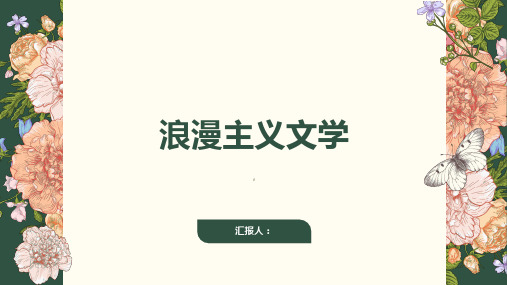
追求理想和 现实的结合
浪漫主义文学 的影响
对世界文学的影响
添加标题
浪漫主义文学对世界文学产生了深远的影响,成为文学史上的一个重要 流派。
添加标题
浪漫主义文学强调个人情感和想象力,对后来的现实主义、现代主义等 文学流派产生了影响。
添加标题
浪漫主义文学对世界文学的影响不仅体现在文学创作上,还体现在文学 批评、文学理论等方面。
感谢您的观看
汇报人:
维克多·雨果: 法国浪漫主义 作家,代表作 《巴黎圣母院》
浪漫主义文学 的特征
强调情感和个性
情感表达:注 重个人情感和 内心世界的表
达
浪漫主义:强 调浪漫、激情
和想象力
个性解放:追 求个性解放和
自我实现
自然主义:崇 尚自然,强调 人与自然的和
谐共生
对自然的热爱和崇尚
自然元素:在作品中大量运用自然元素,如山川、河流、花草等 自然情感:表达对自然的热爱和崇尚,强调人与自然的和谐共生 自然描绘:通过细腻的描绘,展现自然的美丽和神秘 自然象征:将自然元素作为象征,表达作者的思想情感和价值观
浪漫主义文学
汇报人:
目录
01 单击此处添加目录标题内容 03 浪漫主义文学的特征 05 浪漫主义文学的代表作品
02 浪漫主义文学的起源 04 浪漫主义文学的影响 06 浪漫主义文学的意义与价值
添加章节标题
浪漫主义文学 的起源
时代背景
18世纪末至19世 纪初,欧洲社会 动荡不安
工业革命带来社 会变革,传统价 值观受到冲击
代表人物
威廉·华兹华 斯:英国浪漫 主义诗人,代 表作《抒情歌
谣集》
塞缪尔·泰 勒·柯勒律治: 英国浪漫主义 诗人,代表作 《古舟子咏》
英国文学史十八世纪 前浪漫主义 47页PPT文档49页PPT
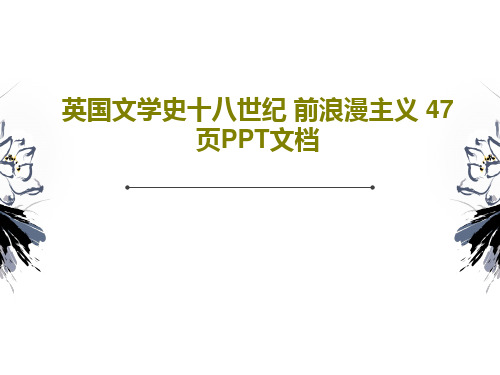
▪
27、只有把抱怨环境的心情,化为上进的力量,才是成功的保证。——罗曼·罗兰
▪
28、知之者不如好之者,好之者不如乐之者。——孔子
▪
29、勇猛、大胆和坚定的决心能够抵得上武器的精良。——达·芬奇
▪
30、意志是一个强壮的盲人,倚靠在明眼的跛子肩上。——叔本华
谢谢!
49
英国文学史十八世纪 前浪漫主义 47 页PPT文档
36、“不可能”这个字(法语是一个字 ),只 在愚人 的字典 中找得 到。--拿 破仑。 37、不要生气要争气,不要看破要突 破,不 要嫉妒 要欣赏 ,不要 托延要 积极, 不要心 动要行 动。 38、勤奋,机会,乐观是成功的三要 素。(注 意:传 统观念 认为勤 奋和机 会是成 功的要 素,但 是经过 统计学 和成功 人士的 分析得 出,乐 观是成 功的第 三要素 。
39、没有不老的誓言,没有不变的承 诺,踏 上旅途 ,义无 反顾。 40、对时间的价值没有没有深切认识 的人, 决不会 坚韧勤 勉。
ห้องสมุดไป่ตู้ ▪
26、要使整个人生都过得舒适、愉快,这是不可能的,因为人类必须具备一种能应付逆境的态度。——卢梭
英国文学史十八世纪 前浪漫主义 47页PPT文档PPT49页
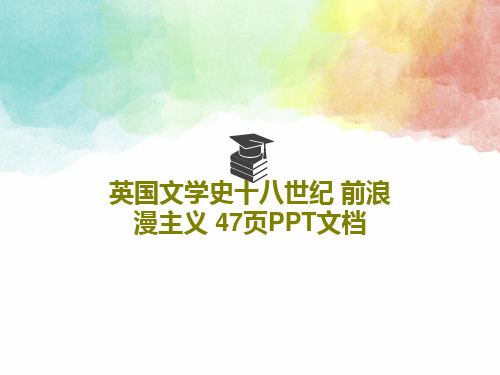
16、业余生活要有意义,不要越轨。——华盛顿 17、一个人即使已登上顶峰,也仍要自强不息。——罗素·贝克 18、最大的挑战和突破在于用人,而用人最大的突破在于信任人。——马云 19、自己活着,就是为了使别人过得更美好。——雷锋 20、要掌握书,莫被书掌握;要为生而读,莫为读而生。——布尔沃
英国文学史十八世备的头脑有特别的 亲和力 。 27、自信是人格的核心。
28、目标的坚定是性格中最必要的力 量泉源 之一, 也是成 功的利 器之一 。没有 它,天 才也会 在矛盾 无定的 迷径中 ,徒劳 无功。- -查士 德斐尔 爵士。 29、困难就是机遇。--温斯顿.丘吉 尔。 30、我奋斗,所以我快乐。--格林斯 潘。
END
英国浪漫主义时期文学 PPT

• Romanticists show in their works their profound dissatisfaction with the social reality and their deep hatred for any political tyranny, economic exploitation and any form of oppression, feudal or bourgeois. In the realm of literature, they revolt against reason, rules, regulation, objectivity, common senses, etc. and emphasize the value of feelings, intuition, freedom, nature, subjectivism, individuality, originality, imagination, etc.
• 8) A feeling of loneliness & a note of mecation of the commonplace--- the aim of good poetry is “to choose incidents and situations from common life” and to use a “selection of language really spoken by men”, and to awaken in the reader “freshness of sensation” in the presentation of “familiar objects”.
- 1、下载文档前请自行甄别文档内容的完整性,平台不提供额外的编辑、内容补充、找答案等附加服务。
- 2、"仅部分预览"的文档,不可在线预览部分如存在完整性等问题,可反馈申请退款(可完整预览的文档不适用该条件!)。
- 3、如文档侵犯您的权益,请联系客服反馈,我们会尽快为您处理(人工客服工作时间:9:00-18:30)。
The first stanza is rural and descriptive, while the second focuses on abstract spiritual matters and contains explanation and analogy. The child’s question is both naive and profound. The question (“who made thee?”) is a simple one, and yet the child is also tapping into the deep and timeless questions that all human beings have, about their own origins and the nature of creation.
It was ushered in by Thomas Percy ----“Reliques of Ancient English Poetry”
2) changing modes in poetry
reject: reason → accept: feelings
society →
nature
flowing l’s and soft vowel sounds contribute
to this effect, and also suggest the bleating of a lamb or the lisping character of a child’s chant.
Commentary
The poem begins with the question, “Little Lamb, who made thee?” The speaker, a child, asks the lamb about its origins: how it came into being, how it acquired its particular manner of feeding, its “clothing” of wool, its “tender voice.”
History and Anthology of English Literature
18th Century -2
(Enlightenment) Classicism ; Sentimentalism ; Pre-romanticism; Realism Romanticism
E. Pre-romanticism in English poetry and novel:
3) William Blake:
the most independent and the most original of the romantic poets of the 18th century
a. Life: engraver b. Works: “Songs of Innocence” “Songs of Experience” P288 P289
The Lamb
Little Lamb, who made thee? Dost thou know who made thee? Gave thee life, and bid thee feed, By the stream and o'er the mead; Gave thee clothing of delight, Softest clothing, woolly, bright; Gave thee such a tender voice, Making all the vales rejoice? Little Lamb, who made thee? Dost thou know who made thee?
In the next stanza, the speaker attempts a riddling answer to his own question: the lamb was made by one who “calls himself a Lamb,” one who resembles in his gentleness both the child and the lamb. The poem ends with the child bestowing a blessing on the lamb.
imitation →
innovation
city →
countryside
• Touching on matters of the heart like love, death, and loyalty, and fresБайду номын сангаас and emotional in tone and mood, the poems contributed a good deal toward reviving interest in and restoring feeling to poetry.
1) Romantic Revival: • a strong protest against the bondage of
Classicism, • a recognition of the claims of passion and
emotion, • a renew interest in medieval literature
Little Lamb, I'll tell thee, Little Lamb, I'll tell thee. He is called by thy name, For He calls Himself a Lamb. He is meek, and He is mild; He became a little child. I a child, and thou a lamb, We are called by His name. Little Lamb, God bless thee! Little Lamb, God bless thee!
Form
“The Lamb” has two stanzas, each containing five rhymed couplets. Repetition in the first and last couplet of each stanza makes these lines into a refrain(叠句;叠歌), and helps to give the poem its song-like quality. The
